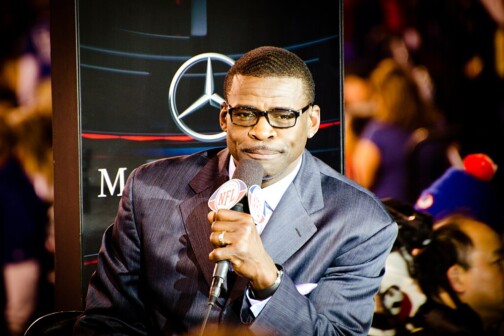How does it feel to have been under siege for a year? Please don’t say you haven’t noticed- you’ll break New Zealand’s heart. Since last Septem- ber, the little South Pacific country has spent millions courting you. That’s “you” as in Dallas, specifically. The blitz began with an official visit by Prime Minister David Lange, who flew here to launch the campaign. It continued through the State Fair, with a whole company of Maori musicians and dancers sent to dazzle us with native color, with free food and a rich spread of leathers and sheepskins, jewelry and artworks displayed in a lavish booth. New Zealand’s top chefs came to work their creative craft for Dallas diners; New Zealand wines were poured, New Zealand beer flowed. April’s annual Beaux Arts ball, benefiting the Dallas Museum of Art, was persuaded to take a New Zealand theme; the affair was a glittering success. All year, Dallas supermarkets and restaurants have wooed you with New Zealand lamb, seafoods, farm-raised venison, and New Zealand cheeses and fruits. The orange roughy you’ve learned to savor, the green-lipped mussels, the ubiquitous kiwi fruit and fine aged cheddars have won you to the brilliant variety of New Zealand’s exportable foods.
But New Zealand itself is the real banquet to win hungry souls. It’s a magical, through-the-looking-glass country where everything is upside down and opposite from the world we know-where cars drive on the wrong side of the road, and bathroom drains and traffic circles swirl backward. Where spring is fall, and summer is winter, so that you could have gone skiing last month instead of sweating through Texas heat. And where you could swim, fish, golf, and scuba your way through January, while Dallas freezes. We could invent all this, except that New Zealand has done it for us. Some impressions:
? We floated over slow waves in a chartered launch, a sea breeze sliding the spring sun’s heat off our shoulders. A while ago, we left the launch to climb steep, green slopes to a 250-foot cliff from which we could see miles of the coves and inlets that give this place its name: the Bay of Islands. As we flew into Auckland via Air New Zealand, my sleep-dulled eyes were struck by the bright, green flatlands that bordered the airport. So this is New Zealand, I thought, and I was both wrong and right. Auckland is Auckland; a busy urban sprawl that contains one-third of the nation’s 3.3 million population, it hardly hints at the scenic charms of the rest of the country.
New Zealand itself is two islands stretching north and south halfway between the Equator and the South Pole, at their closest points a two-hour ferry ride apart. The Bay of Islands is near the near-to-tropical top tip of North Island. During the hundred-mile drive north from Auckland, I learned the true meaning of emerald, in hillsides carved into horizontal rows by grazing sheep, in gentle valleys carpeted with the impossible green you’ve seen in photographs but never believed was real.
We had stayed the night at the Duke of Marlborough, a gracious old ramble of an inn overlooking the piers of Russell, a resort village that teems with yachts and water sportsmen during the height of the December-through-March summer season. After a lazy launch lunch of champagne, smoked salmon, and fruit, we dined on exquisite pumpkin soup, pheasant paté, and a bourbon-sauced lobster tail prepared by a young chef named Warren Bourne, who could be famous anywhere in the States, but who prefers to cook for the few who know to gather at Okiato Lodge. New Zealanders are an independent lot.
? Our next jaunt was with a helicopter pilot who displayed a fine disregard for such piddling concerns as survival. He regretted-more than we did, perhaps-that stormy spring weather wouldn’t let him take us roaring through daredevil river canyons; wouldn’t even let us take the hair-raising jet-boat shoot on the Shotover River.
Didn’t, he might have added, even let us fly by ski-plane from the lodge on Mount Cook to set foot inside a glacier-one of the premier attractions on the South Island for tourists en route to Queenstown. This last is regrettable, but the motorcoach substitute is scenic, too; a winding drive worth watching, wistfully, as the majestic snowpeaked mountain appears and disappears between clouds, on the way to the lodge, the Hermitage, in new-falling snow.
Later, flying into Queenstown, we looked down on mighty mountains, their knife-like edges slicing the sky, then dwindling to foothills shaped in sculptured folds, like a child’s school project in plaster, painted in the olive-to-amber shades of military camouflage.
Queenstown is the athletic heart of South Island. Surrounded by ski slopes, it’s the central jumping-off place for wilderness treks and tours by bus, boat, and air of hard-to-reach Milford Sound and the breathtak-ingly beautiful West Coast Fiordland. The feeling is Alpine; Queenstown sits in the curve of a lake across from the sawtoothed Remarkable Mountains, a skier’s paradise. Once a sheep station, the town exploded with the finding of gold on nearby rivers (Arrowtown, a gold-rush ghost town a few miles away, has been born again as a charming museum-and-small shops village). Long after the gold was exhausted, Queenstown blossomed as a ski center. Now still surrounded by sheep and deer farms, the village is a year-round magnet for visitors- particularly Japanese honeymooners, who are easy to spot: they leap from buses and planes for frenzied picture-taking and shopping, then fall instantly asleep, exhausted, once back in their seats.
The helicopter dropped us tamely up the lake for a sheep-shearing demonstration; then we enjoyed a slow chug back to Queenstown on the Earnslaw, an ancient coal-powered steamship. In the rain-darkened afternoon, the return trip lasted longer than the romantic novelty of the ride.
? We awoke to farm sounds at sunup. Suddenly, an orchestration of cows, dogs, ducks, roosters, a background jitter of little birds, rises through the bedroom window. Impossible to believe the effect wasn’t staged as a wakeup call for a tourist, but no: the sounds are real, and John and Jane Leslie’s farm is a working sheep station whose owners derive genuine pleasure-and some income- by taking part in New Zealand’s Farmstay program. Jane Leslie, by the way, may be the best cook in Blenheim. Her leg of lamb-and-three-vegetables dinner the night before was a triumph of tradition, right down to the patties of whitebait, tiny transparent trout hatchlings hand-netted in streams, and a classic Pavlova dessert, crisp meringue topped with whipped cream and kiwi fruit.
Strangely, this exact meal, which used to be virtually all that New Zealand offered, is hardly available now to travelers-hotels and restaurants have gone nouvelle and ethnic in the isolated country’s haste to out-cosmopolitan the outside world. Well, that’s progress. Farmstay, Homestay, and small private inn facilities, though, perpetuate old-style hospitality in a network that offers modest-priced alternatives to hotels. For travelers by car, no sweeter accommodations exist.
And the drive up the coast to Blenheim from picturebook-British Christchurch was enough reason to rent a car. We moved in four hours from the table-like flatness of coastal plains into gradual rolls of hills, then higher, around winding doubleback curves, while snow-capped mountains rose to our left under rose-gold clouds, the sea-washed beach mere yards from the road to our right. In Texas, vacationers debate whether to head for the hills or the seashore; here, we had both, touching-close. No place in New Zealand is more than seventy miles from the sea, but this stretch of northbound road alone is worth the whole trip to South Island.
? Standing on a sturdy little bridge arched over a narrow roar of water between wooded banks, the view of the raging Wairaki River below is hypnotic. The water is a pale, iced aqua, almost as if lit from within. My “cabin” overlooking these North Island fells is hardly that-the bathroom ceiling is glass; we bathe beneath towering redwoods and pines. The furnishings are first-class in every way. This is Huka Lodge, best-known of all the exclusive New Zealand hunting and fishing lodges, and expensive enough to earn both the fame and the adjective.
● Lake Rotoroa Lodge may be the ultimate. A Victorian mansion-cum-refuge for seclusion-seeking sportsmen of means, Rotoroa is run by former bank officer Bob Haswell, who caters to celebrities. James Michener has slept here. So have Hume Cronyn and Jessica Tandy. Boz Skaggs is a frequent visitor, along with various British nobles and American businessmen willing to pay up to $250 NZ a night, plus guide fees, to hunt or fish for the brown trout that fight back in the river that flows into Rotoroa Lake. Ambience here is casual, more laid-back than at Huka Lodge, but the luxury quotient’s distinctly haute-decanters of brandy, heated beds, and bedcovers are hints of that. So is the private helicopter at hand.
● We are standing on the moon. The helicopter that brought us here is a shining anachronism on cratered croppings of sul-furous ash. This is White Island, an actively smoldering volcano thirty-one miles off the North Island’s northern coast. We flew here from Rotoroa, where Maoris cooked our dinner last night in a hangi, a pit dug in the ground, then entertained us with native dances and story-songs. We danced with them, finally, and saw more of them this morning, in the stockaded confines where boiling geysers raise towers of water and steam, and mud plops and bubbles as thermal heat vents from the earth. White Island is not more impressive, but its sulfur-rimmed blowholes rumble menacingly, and its lifeless terrain may be the bleakest spot in New Zealand. If you must return home to the real world, White Island is surely the easiest place to face the knowledge. It’s the only locale in the country where even a dry-gulch Texan couldn’t live.
Get our weekly recap
Brings new meaning to the phrase Sunday Funday. No spam, ever.
Related Articles

Local News
My Formal Offer to Michael Irvin to Come Work at D Magazine
What it lacks in salary, it makes up for in perks. And friendship?
By Zac Crain

Basketball
What We Saw, What It Felt Like: Mavs-Thunder, Game 1
Outgunned and outclassed.
By Iztok Franko and Mike Piellucci

Healthcare
Meet the Dallas 500: Chris Akeroyd, Children’s Health
The pediatric health system CIO shares why he loves to kickbox, what he would change about the healthcare industry, and his key leadership strategies.
By Will Maddox


